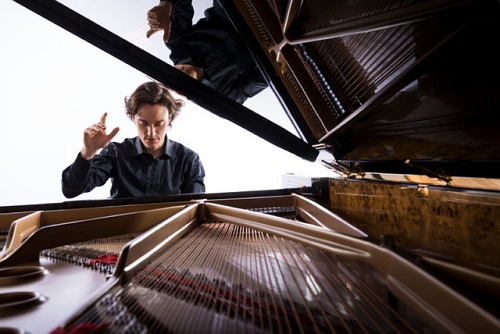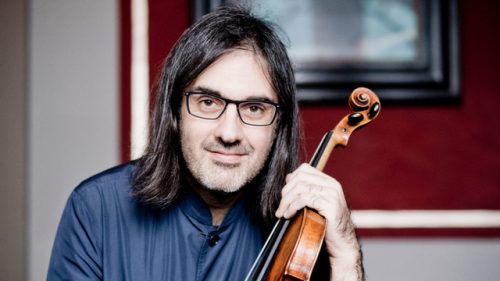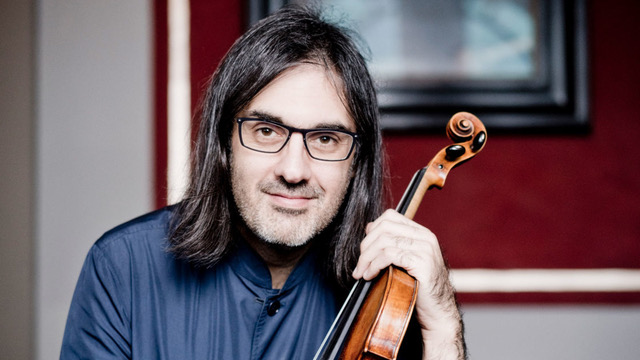 United States Various: Alessandro Taverna (piano), Leonidas Kavakos (violin), Dallas Symphony Orchestra / Fabio Luisi (conductor). Morton H. Meyerson Symphony Center, Dallas. Livestreamed on DSO’s NEXT STAGE Digital Concert Series, 17.2.2021. (RP)
United States Various: Alessandro Taverna (piano), Leonidas Kavakos (violin), Dallas Symphony Orchestra / Fabio Luisi (conductor). Morton H. Meyerson Symphony Center, Dallas. Livestreamed on DSO’s NEXT STAGE Digital Concert Series, 17.2.2021. (RP)

Saint-Saëns & Bizet
Saint-Saëns – Piano Concerto No.2 in G minor Op.22
Bizet – Symphony in C major
Recorded live from 28-31 January 2021
Leonidas & Luisi
Beethoven – Violin Concerto in D major Op.61, Leonore Overture No.1 Op.138
Angélica Negrón – En otra noche, en otro mundo (world premiere)
Recorded live from 4-7 February 2021
Procrastination paid off this time. The sun was shining, the sky was a brilliant blue, and the snow was glistening like diamonds by the time I got around to watching these two digital offerings from the Dallas Symphony Orchestra conducted by Fabio Luisi. Granted, Saint-Saëns’s Piano Concerto No.2 has a stormy opening movement, but soon the music was in sync with the view outside my window. The combination of these performances and a glorious mid-winter’s day with a touch of spring in the air was just the tonic that I needed.
This is Luisi’s first season with the DSO as its music director. In January, he returned to Dallas for a series of live concerts that are being recorded for streamlining through the end of May. This is his ninth and final season as General Music Director of the Zurich opera, where I often heard him conduct, chiefly in opera but occasionally with the fine orchestra on its own. In Zurich, audiences and critics counted their lucky stars to experience his conducting a broad swath of the operatic repertoire, and now Texans have the pleasure in the orchestral realm.
These concerts exemplify Luisi’s strengths. In the standard repertoire, his finely detailed performances drill deep into the emotional core of a work. Luisi is not a showman, and he has proven repeatedly that histrionics are totally unnecessary to achieve thrilling performances that bring an audience to its feet. He also embraces the music of today, and if ever there was a time to embrace contemporary composers, this is it.
Alessandro Taverna was the soloist in the Saint-Saëns, which opened the first of the two concerts. Wearing white tie, tails and a black face mask, Taverna impressed most in the lyrical passages of the concerto, due to his elegant phrasings, subtle dynamic shadings and the luminous sound that flowed from the piano, especially the beautiful melodies of the first movement. In the second one, Taverna delighted with his virtuosic playing and the humor that infused the music. The finale, a flamboyant tarantella, was dazzling for the technical bravura of both soloist and orchestra.
The second concert, with Beethoven’s Violin Concerto and Leonore Overture No.1 on the program, was a reminder of the 250th anniversary celebrations that didn’t take place last year. Due to COVID-19 safety protocols, the DSO has fewer musicians on stage, which is especially noticeable in the string section, and it lent an intimate air to this performance. Luisi led stately accounts of both works that were notable for the transparency and brilliance of the orchestral sound.

In the Violin Concerto, Leonidas Kavakos’s playing cast a spell over me due to the exquisite purity of his sound, particularly in the high positions where so much of the solo violin part lies. There was also earthiness when called for, particularly in the biting attacks and in the spirited rondo, but it is the singing, sweet stillness of his sound that lingers in the mind.
Sandwiched between the two Beethoven works was the world premiere of Angélica Negrón’s En otra noche, en otro mundo (On Another Night, In Another World ). Negrón, the DSO’s Composer-in-Residence, took the title of her work from a poem by the twentieth-century Argentinian poet Alejandra Pizarnik. Born in Buenos Aires to Russian Jewish immigrant parents, Pizarnik moved to Paris, where she committed suicide at the age of 36. Her themes were cruelty, childhood, estrangement and death, which she wrote about in a terse style that she called unbeautiful, a term that cannot be applied to the music it inspired.
In En otra noche, en otro mundo, Negrón evokes a distant but strangely familiar landscape that travels between different worlds. It is also a personal reflection on her inability to be present in the moment and a constant desire to escape to a different time and place. Musically, she looked to Arvo Pärt for inspiration, to his tintinnabuli approach to composing to create atmospheric and immersive textures, swelling patterns and shifting rhythms that evoke longing and yearning for something that may never come.
En otra noche, en otro mundo is stunning. Harp, organ and electronics combine to create a shimmering patina of sound upon which the woodwinds, brass and percussion cast their magic. The influence of Pärt is readily apparent, but the spaciousness of the sound, particularly in the music that she wrote for the brass, is reminiscent of Aaron Copland. For all of the longing and mystery in En otra noche, en otro mundo, there is also the promise of hope.
By the time that I finished this review, winter had returned to northern New Jersey, although the dusting of snow only served to refresh the winter landscape. In Texas, where once-in-a-century storms have created havoc, the Dallas Symphony Orchestra has had to cancel this week’s concerts of the music of Mozart and Strauss. One hopes they will be rescheduled but, fortunately, there are these two concerts to savor.
Rick Perdian
For more on the DSO’s NEXT STAGE Digital Concert Series, click here.
